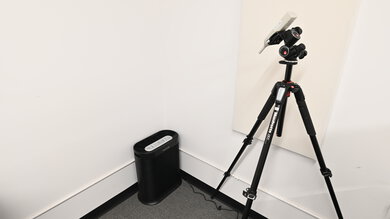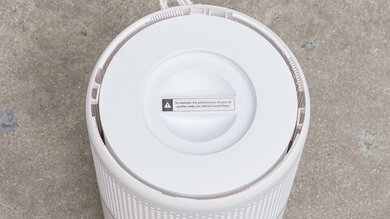- Table of Contents
- Intro
- Best Air Purifier
- Best Budget
- Best Compact
- Best DIY
- Notable Mentions
- Recent Updates
- All Reviews
- Comments

If you're dealing with a lot of dust at home, it might be time to invest in an air purifier. The best options can minimize dust buildup by efficiently locking in particles like pet dander or pollen, even within larger rooms. Now, it's important to note that an air purifier won't solve all your dust woes by itself: generally speaking, you'll want to vacuum as much as possible to minimize dust buildup so your air purifier won't have to work as hard. If you're looking for vacuum recommendations, you can see our picks for the best vacuum cleaners and the best vacuums for allergies.
We've tested over 25 air purifiers; below are the best air purifiers for dust removal. For a broader overview of the product landscape, check out our recommendations for the best air purifiers, the best air purifiers for pets, and the best large-room air purifiers.
-
Best Air Purifier For Dust
Pets7.8Bedroom6.1Performance Usages: Particle Filtration Rate8.7Particle Concentration8.9The Honeywell HPA300 is the best air purifier for dust we've tested. This unit provides great overall performance, as it has a two-stage filtration system that includes a carbon pre-filter sheet and a trio of separate HEPA filters, resulting in excellent particle filtration. You'll need to swap out the carbon filter every three months and the HEPA filters every year, which is fairly standard for household air purifiers. Unfortunately, this unit is quite large and gets pretty loud at higher fan speeds. It's also worth noting that this is a pretty basic machine, lacking features like air quality sensors and Wi-Fi connectivity.
If you're willing to spend more in exchange for a broader array of convenience features, including an app that allows for remote control, consider the Levoit Core 600S. Just note that it doesn't work quite as fast in clearing the air of particulate matter compared to the Honeywell.
-
Best Budget Air Purifier For Dust
Pets7.4Bedroom7.9Performance Usages: Particle Filtration Rate7.1Particle Concentration8.7Check out the Levoit Core 300 for a budget-friendly solution to excess dust. This air purifier has a much lower clean air delivery rate than the Honeywell HPA300, so it works more slowly, especially in larger spaces. That said, it still offers excellent overall filtration as long as you keep its fan on a higher speed setting. It's also cheaper, smaller, and much quieter, so it won't be as disruptive in a living room or bedroom. Like the Honeywell, this air purifier is a simple device, so you won't find WI-FI connectivity or built-in particle sensors, but if you're looking for good filtration at a price that won't break the bank, it's a solid pick.
If you want to customize its performance, you'll be happy to hear that this machine is compatible with specialized Levoit filters meant to capture various types of allergens. You can choose between the 4-Stage Smoke Remover filter, the 3-Stage Toxin Absorber filter, and the 3-Stage Pet Allergy filter. While we haven't tested these filters yet, we expect them to perform similarly.
-
Best Compact Air Purifier For Dust
Pets6.9Bedroom7.4Performance Usages: Particle Filtration Rate6.7Particle Concentration7.9If you want a compact air purifier for dealing with dust, the Levoit Core 200S is a great choice. While it can't compete with a full-size unit like the Honeywell HPA300 in terms of clean air delivery rate and has a main filter that isn't HEPA-rated, it still delivers impressive overall particle filtration, especially given its compact size. This makes it a good option for bedrooms, offices, dorms, and other small spaces. It has Wi-Fi connectivity and access to the VeSync companion app, allowing you to run the device while you're away from home, set operating schedules, and even give it voice commands through Amazon Alexa or Google Assistant. You can also set up reminders to replace its filters, which you'll need to do every six to eight months.
Like the other options listed here, it lacks a built-in particle sensor that would allow it to adjust its fan speed automatically depending on real-time air quality.
-
A DIY Air Purifier For Dust
Pets7.7Bedroom4.3Performance Usages: Particle Filtration Rate9.5Particle Concentration8.8If you're looking for an air purifier to deal with dust and don't mind working with your hands, you could also build your own Corsi-Rosenthal Box. We built ours by following this guide, which uses a set of 3M Filtrete MERV 13 air filters built around a Lasko 20-inch box fan. This DIY solution takes all the benefits and drawbacks of the Honeywell HPA300 to the extreme: it's even bigger and louder than the already cumbersome Honeywell, but it also offers outstanding particle filtration and a sky-high clean air delivery rate. These factors make it a good option for big areas where noise and aesthetics are of minimal concern, like a workshop or an unfinished basement. Unfortunately, operating costs for a Corsi-Rosenthal box can be a little high, as you'll need to swap out all four filters once they've hit the end of their useful lifespan.
Some users have iterated on this basic design by swapping out the large box fan for multiple PC cooling fans, resulting in quieter operation and lower power consumption. However, we haven't built or tested a Corsi-Rosenthal Box using this design yet.
Notable Mentions
- NuWave OxyPure:
The NuWave OxyPure is a premium air purifier with a multi-stage filtration system using washable filters. It offers more convenience features than the Honeywell HPA300 and runs more quietly, but it's also far more expensive, and its particle filtration performance is ultimately only comparable.
See our review - Levoit Vital 200S:
The Levoit Vital 200S is a good alternative to the Honeywell HPA300 if you want a unit with Wi-Fi connectivity. While it offers comparable overall performance, its main filter lacks HEPA certification.
See our review
Recent Updates
-
Due to changes in pricing, we've replaced the Winix 5500-2 with the Levoit Core 300 as our budget pick. We also made minor edits for clarity.
-
We corrected the link to the Corsi-Rosenthal Box. We checked all recommendations for accuracy and current availability. No changes were required.
-
Ensured all main picks remain in stock and represent the best choice for user needs.
-
Small text changes for conciseness and clarity. No change in recommendations.
-
We've made minor updates to the text and checked that the products are in stock. Our recommendations have remained unchanged.
All Reviews
Our recommendations above are some of the best air purifiers for dust removal for most people. We factor in the price, feedback from our visitors, and availability.
That said, there's no single best option that will suit everybody; your needs will depend on your budget, the size of your living space, your tolerance for operating noise, and whether you like having a device with convenience features like Wi-Fi connectivity. If you'd like to choose for yourself, here's the list of all our air purifier reviews.
Comments
Best Air Purifiers For Dust: Main Discussion
What do you think of our picks? Let us know below.
Looking for a personalized buying recommendation from the RTINGS.com experts? Insiders have direct access to buying advice on our insider forum.
Update: Due to changes in pricing, we’ve replaced the Winix 5500-2 with the Levoit Core 300 as our budget pick. We also made minor edits for clarity.
What do you think of these changes? Let us know





















